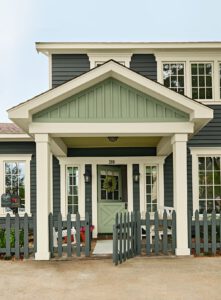Nothing gives a home a quick, impressive facelift like a fresh coat of paint. And whether you’re trying to sell or simply enjoy the aesthetic, new types of paint last longer and require fewer touch-ups than ever before.
The key to longevity is choosing an exterior paint with a good level of resistance to weather and moisture. This includes everything from sleet and snow to wet and humid summers. For professional assistance, call Exterior Painting Dallas.
The term “curb appeal” refers to the attractiveness of a property and its surroundings as seen from the street or sidewalk. While many people believe that curb appeal is only important when trying to sell a home, it’s actually an excellent way to increase personal satisfaction with a property and help protect or maintain its value.
There are a variety of ways to improve curb appeal, but one of the easiest and most cost-efficient is exterior painting. A new layer of paint will immediately make a house look better and can protect it from moisture-related damage like rot, mildew, and mold. If you’re considering selling your home in the future, curb appeal is especially important, as it is one of the most effective tools to use when attempting to attract potential buyers.
A freshly painted front door is an easy and inexpensive way to drastically improve curb appeal. If your doors are dull, faded, or even chipped, a fresh coat of paint can give them an instant facelift. Changing the color of your home’s siding is also an effective way to improve curb appeal. It is typically recommended to choose a natural color that complements the other colors of your home and its surrounding landscaping.
Decorative hardware, windows, railings, and porch supports are another aspect of your home that can be easily updated with a fresh coat of paint. A professional will be able to guide you on what colors will work best and complement the existing materials.
An often overlooked aspect of curb appeal is the driveway and walkway up to your home. A boring, paved walkway can be quickly transformed into something more inviting with a few stones or a cool flagstone design. If the current walkway is uneven or chipped, a concrete patch job can be done quickly and cost-effectively.
Many homeowners don’t think to address the small things that can have a big impact on curb appeal. It’s also a good idea to repaint your gutters and downspouts once in a while so they stay nice.
Durability
Many factors can affect the lifespan of an exterior paint job, including the material it is applied to and whether or not it is properly prepared. Generally, painting experts recommend that homes be painted every five to ten years. However, the timeframe can vary considerably depending on the location and general weather conditions.
The type of paint used can also have a significant impact on how long the surface lasts. Those who choose high-quality paints that are designed for use on the particular surfaces to which they will be applied usually find that their new coatings last longer than those who opt for cheaper options.
For example, a wood surface tends to degrade more quickly than a brick or stucco surface. It is also important to make sure that the new paint is compatible with the original coating and that it is applied in accordance with the manufacturer’s instructions.
Another factor that can have an impact is the amount of sunlight to which the surface is exposed. While direct sunlight will not chip the paint, it can cause it to fade over time, which will become more noticeable on darker colors than on lighter hues.
While all paints contain similar basic ingredients, those designed for exterior use are often manufactured with different resins to make them more flexible and durable than interior paint. This is because exterior paint must be able to withstand huge temperature changes and moisture while also resisting cracking, peeling, and flaking. For this reason, the resins used in manufacturing exterior paints are typically softer than those used to make interior paints.
It is essential to use quality caulking and primers when applying new paint and to make sure that the surface is clean before starting. This will help to ensure that the paint adheres well, and it will also reduce moisture infiltration, which can lead to mildew and mold growth. Finally, it is a good idea to apply the first coat of paint in a low-traffic area and to let it dry for at least 24 hours before moving on.
Energy Efficiency
Depending on the climate in which you live, your home’s exterior color can significantly affect its energy efficiency. Dark-colored paints absorb more heat from the sun, which can lead to increased cooling costs during the summer months. Light-colored paints, on the other hand, reflect more of the sun’s heat and can help lower cooling costs during the summer.
The choice of paint color and finish can also impact the energy efficiency of a building’s walls. A flat finish is more porous and absorbs more heat, while a glossy finish is more reflective and can reduce energy costs by reducing the amount of heat transferred into the building.
Energy-efficient exterior paints are formulated to contain more reflective pigments and have a higher Solar Reflectance Index (SRI) than regular paints, meaning they reflect more of the sun’s heat and insulate your home more effectively. They also reduce thermal bridging, which is when heat passes through less insulated materials like wall studs and window frames, causing energy loss.
While whites continue to be popular exterior paint colors, the hues are slowly shifting away from pure whites to more nuanced options with restful energy. These shades offer a sophisticated look while still maintaining the natural brightness that many homeowners prefer.
High-quality exterior paint lasts longer than lower-grade products and may require repainting less often. However, the cost of quality paint is higher, so it’s important to consider your budget and needs before making a purchase.
Prepping the walls before painting is an essential part of any exterior painting project. This includes removing any debris or mold and ensuring the surface is dry before beginning the process. Additionally, any cracks or holes should be caulked to prevent moisture from entering the walls and causing damage.
The preparation process also includes covering windows, doors, and other surfaces that you don’t want to get paint on. This will help prevent accidents and save you time in the long run. Additionally, it’s best to hire a professional rather than try to do the work yourself. This way, you can be sure that the job will be done correctly and efficiently.
Health
A fresh coat of paint will not only revive your home’s aesthetics but also protect its underlying materials from moisture. Signs that your home needs a new coat of paint include peeling, flaking, or cracking. Repainting your house’s exterior at the first signs of wear will prevent more serious issues like mold, mildew, or dry rot from developing.
When choosing exterior paint, look for a high-quality formula that is scrubbable and water-resistant. Investing in quality paint will allow you to paint your home fewer times over the years, and it will also provide better coverage for each application, saving you time and money in the long run.
The paint you choose must be suitable for your climate and the underlying material of your house. Wood siding, for example, will require different preparation than masonry or stucco. Before starting to paint, use a ladder or scaffolding suited to the height of your home’s exterior. In addition, make sure to erect safety barriers around your yard and any structures you don’t want painted, such as sheds or fences.
Painting produces harmful vapors that can irritate your eyes, nose, and throat if exposed for prolonged periods. Ensure that your work area is properly ventilated to remove these vapors from the air. If you are using a water-based paint, opening a window is sufficient; for alkyd or casein paints that contain ammonium hydroxide, you will need an exhaust fan.
When purchasing your paint, be sure to purchase 10 percent more than you need to account for waste. It is also a good idea to mix all of your cans together before applying them, as this will help ensure that the color is consistent throughout your project.
Be sure to follow all manufacturer instructions regarding the proper application of your chosen paint. Additionally, it is important to use a primer that is compatible with your siding. Depending on the type of siding, the primer may need to cure for a few days before you can apply your finish paint. Always wear a mask when working with hazardous materials such as turpentine and solvents. It’s also a good idea to cover any areas of your home that you won’t be painting with plastic sheeting or drop cloths.
